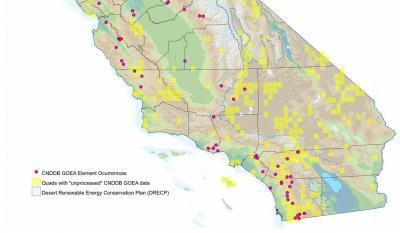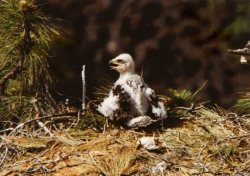
Disturbing data suggests Golden Eagles appear on verge of extinction in our region
By Miriam Raftery
February 15, 2014 (San Diego’s East County) –A state inventory of California’ rarest animals, birds and plants reveals that Golden Eagle populations have suffered a precipitous decline statewide, including here in San Diego County. Statewide, only 141 element occurrences (eagle nests and foraging habitat) are listed in all of California. Locally, the inventory lists just 14 “occurrences” countywide—with only one nest remaining in East County.
“So much for Bittner’s estimates,” wildlife biologist Jim Wiegand with Save the Eagles International told ECM. David Bittner is the so-called eagle expert hired by major energy companies to justify wind projects locally. Bittner was convicted in federal court and sentenced in August to charges of failing to file data reports with the federal government and illegal taking of an eagle.
Wiegand has previously estimated local nesting sites at 10--a fraction of Bittner's recent estimates.
Now, he says, “The 14 Golden Eagle occurrences listed for San Diego County probably represent no more than 8 nesting pairs of Golden Eagles. The one listed furthest to the east is most likely the cane brake nest site that will disappear if the Tule ridgeline wind project is approved. In the plans I looked at, massive wind turbines will be installed only a short distance from this nest site. These turbines would be so close that there are probably plans to destroy this nest site and force the eagles to relocate. It will not matter because the eagles will still have to forage in this territory and will eventually be killed off." (Note: Wiegand has amended his assessment of this nest and we have updated the story to include this revision.)
Bittner had recently estimated that San Diego was home to 48 nesting pairs of Golden Eagles –and insisted that wind turbines posed no significant danger to them, though he claimed no active nesting sites existing near proposed turbine sites. His Wildlife Research Institute in Ramona had acknowledged a decline in eagle populations locally, but blamed that decline on hikers getting too close to nests.
Wiegand has suggested that wind turbines in Campo and Ocotillo may be to blame for eagle deaths, citing alarmingly high rates of eagle deaths at wind projects elsewhere, including the infamous Altamont Pass wind famr which has reportedly killed thousands of eagles through the years.
 Bittner has taken over $600,000 recently from energy companies as a consultant on projects including Ocotillo Wind in Imperial Valley, Tule Wind in San Diego County’s ’s McCain Valley, and Energia Juarez Wind in Baja, Mexico.
Bittner has taken over $600,000 recently from energy companies as a consultant on projects including Ocotillo Wind in Imperial Valley, Tule Wind in San Diego County’s ’s McCain Valley, and Energia Juarez Wind in Baja, Mexico.
Wiegand estimates that in all of California, only 75 to 90 nesting pairs of Golden Eagles remain. He notes that the California Natural Diversity Database, the inventory conducted by the state, reveals that approximately half of the state’s 58 counties now have no known Golden Eagle nesting sites. His estimate is based on data from a 2012 Bureau of Land Management survey and WRI data as well as the state’s inventory.
Rewire has reported that even before the state inventory data, Wiegand predicted that the Tule Wind project (recently approved by the federal government) could "devastate" Golden Eagles in our region, Rewire reported.
Despite these seemingly alarming facts, federal, state and county governments continue to approve and consider future projects for which Bittner provided the raptor studies, instead of ordering a moratorium on any new major project construction that relied on Bittner’s data pending evaluation by an independent wildlife biologist. Even more shocking in the wake of the species' precipitous decline here, Iberdrola Wind is expected to apply for "take" permits for its Tule Wind project, allowing it to kill a limited number of Golden Eagles without risk of prosecution or fines.
For anyone else who kills eagles, there are steep federal penalties.
If the state’s inventory is accurate, Tule Wind could spell the death knoll for the species in our region, if built.
Correction: After this ran, the California Department of Fish and Game has advised us that the California Natural Diversity Database, which contains information on 898 animals and over 2,000 plant species in California, “is not meant to be the exclusive source of data for each of these species. We work very hard to keep the CNDDB as up-to-date as possible given our capabilities and resources. However, we cannot and do not portray the CNDDB as an exhaustive and comprehensive inventory of all rare species and natural communities statewide.” Our story linked to a research symposium site that included a chart and data from the database, but was not the actual report. This described the number of golden eagle occurrences (141) that were in the CNDDB as of 2012, also statingthat other existing data on Golden Eagle occurrences is not in the CNDDB and listed 201 “unprocessed” sources of data on golden eagles in the CNDB. Accordingt to Jordan Traverso at CDFG, “These represent additional sources of information on golden eagle occurrences that have not been screened as to whether they are valid reports of Golden Eagle nest sites. These unprocessed sources are represented on the map as yellow rectangles reflecting the U.S. Geological Survey 7.5 minute topographic maps the observations are reported from. Thus, uncertainty in the number of golden eagle occurrences is implied by the map.”
The California Department of Fish and Wildlife is currently taking part in an effort to assess the conservation status of golden eagles. For additional information see the California and Nevada Golden Eagle Working Group website (http://www.dfg.ca.gov/wildlife/nongame/GEWG/), and the website for the California Natural Diversity Database (https://www.dfg.ca.gov/biogeodata/cnddb/).
(Editor’s note: It is worth noting that the “unprocessed” data areas include areas surveyed by David Bittner, who was recently sentenced in federal court for refusing to turn over his raptor data to government officials after conducting surveys for energy companies and concluding projects posed on threats to eagles. Since this story was published, ECM has been informed of several reported Golden Eagle nests in East County, including one at Lake Morena confirmed by two rangers; the latter appears to be within the area covered by the Tule Wind EIR but is not mentioned in the EIR.)
We later asked CDF why this report is taking so long given the threats to eagles from wind projects statewide, and we received this response from Jordan Traverso,deputy director of communications, outreach and education:
"Threats to golden eagles and other raptors, particularly around wind energy development, are an issue we take seriously and are actively working on. CDFW is participating in the CA/NV Golden Eagle Working Group; a multi-agency effort to look at golden eagle research and conservation throughout California and Nevada, including potential impacts from reneable energy, and large scale coordination among researchers and project proponents. As part of this effort, information on golden eagle observations is currently being compiled into a comprehensive map of golden eagle nest locations. We recommend you contact the CA/NV Golden Eagle Working Group (http://www.dfg.ca.gov/wildlife/nongame/GEWG/) for additional information. All of the golden eagle data submitted to, but unprocessed by, CNDDB is being mapped as part of this effort. If you are aware of golden eagle nest locations, we encourage you to submit your observations to CDFW (http://www.dfg.ca.gov/biogeodata/cnddb/submitting_data_to_cnddb.asp) for entry into this dataset. Regarding unprocessed records on golden eagles- the CNDDB tracks 898 species of animal and over 2,000 species of plants. Balancing data entry for these taxa is an ongoing process that depends on the volume of data for an individual species, and current conservation priorities across California. For birds, we generally track only nesting observations, but receive many observations of locations where birds are in flight, requiring review of a large number of records to determine which observations represent nesting observations. Again, we are actively working on mapping and cataloging observations of golden eagles across California and Nevada."







Comments
Recent Disinformatiom
Golden Eagle nests
Golden Eagle nests
Ask Mr. Bittner - the eagle expert
Golden eagles
Understanding the CNDDB Database
I photographed a pair of bald eagles last at Lake Cuyamaca;